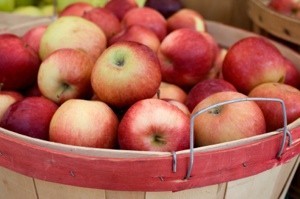
When I think of fall, my mind goes to new pencils and pumpkins and, of course, apples. If you are lucky enough to have an orchard near you, this is the time of year to go and get yourself a bushel of apples. You will need to set aside a weekend and gather some good friends but it will be well worth the work and effort that you put into your apples. In this article, I am going to give you directions for making applesauce and some other goodies. But first let's talk about apples.
Modern refrigeration has changed the way that we look at fruits. Most fruit is available at any time in any area, and it is easy to forget that fruit is seasonal and is actually being grown somewhere. All fruit has an optimum season when flavor, freshness and nutritional value are at their peak.
Every region of the country has its own distinctive varieties, and a visit to the orchard will help you discover which ones are best in your area. When you buy local produce, there are many benefits. Supporting local growers helps preserve family farms. Strong local agriculture is a check on sprawl. Buying locally is the best way to be sure you are putting the most nutritious food on your table. Buying fruit at the orchard is a lot more fun than pushing a shopping cart. Here is a website where you can go to find a local orchard near you:
Look for smooth skin with few bruises. Too many bruises mean the apple may rot. Apples should be stored in the refrigerator, not necessarily the crisper. Choose apples with a bright and sparkly color. Don't buy bagged apples on sale. Apples arrive at stores preserved with nitrogen. After the nitrogen seal is broken, produce managers know they have 23 days to sell the apples. They bag apples for a quick sale after they hit about the 20 day mark.
Apples keep best when refrigerated. Store them in a plastic bag or the drawer to keep them fresh. When you buy apples, put them in a clean plastic bag (a bread bag works well), close it with a twist-tie and make a dozen holes in the bag. That allows ethylene gas to escape but also helps the apples retain moisture. Check them often. Remove any decayed apples. One rotten apple can indeed spoil the whole barrel! Raw, cut apples may darken.
There are many varieties of apples. Some are great for making pies and some are great for just eating.
Apple Equivalents, Measures, and Substitutions
Apples are: fat free; saturated fat free; sodium free; cholesterol free; and an excellent source of fiber.
Here are some recipes to get you started on your apple adventure. Don't be afraid to substitute different types of apples in any recipe. Or to use 2 or 3 different kinds as long as you stick with all eating apples or all cooking apples.
Select firm textured apples for drying. To prepare the fruit, wash and slice into 1/4 to 1/2 inch slices. Pre-treat with a lemon juice/water solution (1 cup of lemon juice to 1 quart of water) or an ascorbic acid (Vitamin C) solution to prevent browning. Place slices onto drying rack. Dry fruit at 135 degrees F. When fruit is pliable and there is no sign of moisture it can be stored in air tight bags or jars. After proper drying, apples and pears will keep in a cool, dry place from six months to a year.
Add tea bags to boiling water. Let stand 15 minutes. Remove and add allspice, honey and apple juice. Simmer over low heat until honey is blended, about one minute. Chill. Serve over ice with lemon slices.
Core apples without cutting through the bottom end. Peel about one third of way down. Place in baking dish. Mix sugar, raisins, cinnamon and nutmeg and fill centers of apples. Dot with margarine and pour water into baking dish. Bake at 375 degrees F about 50-60 minutes or until apples are tender.
Prepare your pastry for a two crust pie. Wipe, quarter, core, peel, and slice apples; measure to 6 cups. Combine sugar and cinnamon. The amount of sugar used depends on how tart your apples are. Arrange apples in layers in pastry lined pie plate. Sprinkle each layer with sugar and cinnamon. Dot top layer with small pieces of butter or margarine. Cover with top crust. Place on lowest rack in oven preheated to 450 degrees F (230 degrees C). Bake for 10 minutes, then reduce oven temperature to 350 degrees F (175 degrees C). Bake for 30 to 35 minutes longer. Serve warm or cold.
Cook the apples in the liquid until soft. Pass through a food mill. Add 1/2 cup brown sugar for each cup of puree. Add the spices, rind and lemon juice and cook over very low heat until thick and dark brown. This may take 3 to 4 hours. If not to be used within a week or two, pour into hot sterilized jars and seal tightly. This can also be put into plastic jars and frozen.
Core and quarter apples. Put in a heavy saucepan with a closely fitting lid, add water, and cook over low heat until very soft. Puree through a food mill and add sugar and cinnamon. This can be frozen in jars or plastic zip lock bags.

About The Author: Debra Frick is a mother of 5 and a grandmother to 8 grandsons and one granddaughter. She is a published author and poetress. Recycling and saving money are her passions. She also loves crocheting and cooking. She is also a pet rescue volunteer and has many pets of her own.
Add your voice! Click below to comment. ThriftyFun is powered by your wisdom!
Apple chutney. Take 1 1/2kg granny smith apples, peeled, cored, and chopped. 500g onions, finely chopped,1 clove garlic, crushed, 700g soft brown sugar, 5ml ground ginger, 2ml cayenne pepper, 10ml salt, 500ml cider vinegar. Place all the ingredients in a large pot and mix well. ring to boil and cook gently for about 2 hours or until it is thick and well cooked. Bottle when cold. Thanks Dorothy
Thanks for all the tips and recipes. We're going to pick our next week.
After drying and storing apples. Do you re-hydrate them or just use as is?
Add your voice! Click below to comment. ThriftyFun is powered by your wisdom!